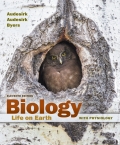
Concept explainers
The name of the process by which DNA is transferred from one prokaryote to another via a cytoplasmic bridge is
a. conjugation.
b. prokaryotic fission.
c. meiosis.
d. bioremediation.
Introduction:
The prokaryotes reproduce asexually, which means the process of genetic recombination is not possible in these organisms. However, it is noted that the transfer of genetic material from one prokaryote to another is possible in certain species. This process involves the formation of a cytoplasmic bridge.
Answer to Problem 1MC
Correct answer:
Conjugation is the process, by which deoxyribonucleic acid (DNA) is transferred from one prokaryote to another via a cytoplasmic bridge.
Explanation of Solution
Explanation for the correct answer:
Option (a) is given that conjugation is the process, by which DNA is transferred from one prokaryote to another. DNA is the genetic material found in the prokaryotes. The prokaryotes undergo asexual reproduction. Thus, genetic recombination is not possible in the prokaryotes. To overcome this problem, the prokaryotes undergo a process where they can transfer the genetic material from other prokaryotes.
In this process, the plasma membranes of two prokaryotes fuse temporarily. This structure is known as the cytoplasmic bridge. The prokaryotes exchange the genetic material via this structure. It leads to the new combination of genetic material, which helps bacteria to survive under different conditions. This process is known as conjugation. Hence, option (a) is correct.
Explanation for incorrect answers:
Option (b) is given that in prokaryotes, DNA is transferred by the process known as prokaryotic fission. Prokaryotic fission is the process, by which prokaryotes reproduce asexually. However, there is no transfer of the genetic material from one prokaryote to another in this process. So, it is an incorrect option.
Option (c) is given that in prokaryotes, DNA is transferred by the process known as meiosis. Meiosis is a cell division process, in which the daughter cells contain half the number of chromosomes as compared to the parent cell. This process is not involved in the transfer of the genetic material from one prokaryote to another. So, it is an incorrect option.
Option (d) is given that in prokaryotes, DNA is transferred by the process known as bioremediation. Bioremediation refers to manipulating the environmental conditions to stimulate the breakdown of the pollutants by living organisms. This process does not involve the transfer of the genetic material from one prokaryote to another. So, it is an incorrect option.
Hence, options (b), (c), and (d) are incorrect.
Therefore, it can be concluded that in the conjugation process, prokaryotes transfer the genetic material via a cytoplasmic bridge from one prokaryote to another.
Want to see more full solutions like this?
Chapter 20 Solutions
EBK BIOLOGY
- 1. Match each vocabulary term to its best descriptor A. affinity B. efficacy C. inert D. mimic E. how drugs move through body F. how drugs bind Kd Bmax Agonist Antagonist Pharmacokinetics Pharmacodynamicsarrow_forward50 mg dose of a drug is given orally to a patient. The bioavailability of the drug is 0.2. What is the volume of distribution of the drug if the plasma concentration is 1 mg/L? Be sure to provide units.arrow_forwardDetermine Kd and Bmax from the following Scatchard plot. Make sure to include units.arrow_forward
- Choose a catecholamine neurotransmitter and describe/draw the components of the synapse important for its signaling including synthesis, packaging into vesicles, receptors, transporters/degradative enzymes. Describe 2 drugs that can act on this system.arrow_forwardThe following figure is from Caterina et al. The capsaicin receptor: a heat activated ion channel in the pain pathway. Nature, 1997. Black boxes indicate capsaicin, white circles indicate resinferatoxin. a) Which has a higher potency? b) Which is has a higher efficacy? c) What is the approximate Kd of capsaicin in uM? (you can round to the nearest power of 10)arrow_forwardWhat is the rate-limiting-step for serotonin synthesis?arrow_forward

 Concepts of BiologyBiologyISBN:9781938168116Author:Samantha Fowler, Rebecca Roush, James WisePublisher:OpenStax College
Concepts of BiologyBiologyISBN:9781938168116Author:Samantha Fowler, Rebecca Roush, James WisePublisher:OpenStax College Biology Today and Tomorrow without Physiology (Mi...BiologyISBN:9781305117396Author:Cecie Starr, Christine Evers, Lisa StarrPublisher:Cengage Learning
Biology Today and Tomorrow without Physiology (Mi...BiologyISBN:9781305117396Author:Cecie Starr, Christine Evers, Lisa StarrPublisher:Cengage Learning Comprehensive Medical Assisting: Administrative a...NursingISBN:9781305964792Author:Wilburta Q. Lindh, Carol D. Tamparo, Barbara M. Dahl, Julie Morris, Cindy CorreaPublisher:Cengage LearningBasic Clinical Lab Competencies for Respiratory C...NursingISBN:9781285244662Author:WhitePublisher:Cengage
Comprehensive Medical Assisting: Administrative a...NursingISBN:9781305964792Author:Wilburta Q. Lindh, Carol D. Tamparo, Barbara M. Dahl, Julie Morris, Cindy CorreaPublisher:Cengage LearningBasic Clinical Lab Competencies for Respiratory C...NursingISBN:9781285244662Author:WhitePublisher:Cengage





